from:
Prestel museum guide, text by Denise Daenzer and Tina
Wodiunig: Native Museum of Zurich (orig. German:
Indianermuseum Zürich / Indianermuseum der Stadt
Zürich); Prestel edition; Munich, New York 1996;
supported by Cassinelli Vogel foundation, Zurich, by
MIGROS percent for culture, by Volkart foundation in
Winterthur; ISBN 3-7913-1635-4
<Wicker work
[Basket making before the
pottery age]
Basket production is one of the oldest North American
handicrafts and is considered as the "mother" of native
handicrafts and arts. Already before the confrontation
with the whites there were known a lot of wicker work
techniques in North America for the production of clothes,
masks, mats, rattles, fish traps, bearing installations,
bags, vessels and jewelry. Yet before developing pottery
production in North America natives were capable producing
water proof jugs and vessels by wicker work preparing them
at the inner side and outside with resins and were put
into the fervors for cooking. The basket vessels were
widespread in whole North America and had central
importance for storage, preparation and giving out food;
only in the region of the Prairies and Plains natives
preferred to use leather vessels. South West area was the
first where the cooking pots in wicker work were
substituted by pottery vessels. (The word "Pueblo" -
Spanish for "village" - names native villages as also the
dwellers of South West North America9. Nomads of this
region - above all Apaches and Navajos - stayed longer
with the baskets in wicker work because they were lighter
and and the danger of breaking was less than with pottery
vessels. Only with the upcoming of commercial pottery in
any kind of form imported by the whites the basket vessels
lost their meaning in native daily life - with the
exception of South West region where the baskets have an
important use in many ceremonies until today. Then with
the revival of native handicrafts in the 1960s also wicker
work saw a new boom. But with this boom only Hopi and
Papago primary nations succeeded in converting the wicker
work production into a profitable branch of their economy.
[Some rules about wicker
work with primary nations]
Wicker work in North America is almost exclusively a
domain of women, and mostly it's an anonymous work - well,
there are some exceptions. Like pottery work also this
handicraft of wicker work has got some taboos. So, Hopi
girls and young Hopi women are forbidden to finish a
basket work completely because when they would cut the
outstanding wattle work finishing the basket, they would
give the signal to the gods that they would not want to
have children any more. But this impression has to be
prevented because fertility is rated as important in these
societies (p.27).
Like the ceramist, also the woman wicker workers have know
well their region because they have to harvest the natural
raw materials. For wicker work can be used grasses, roots,
quills, rods, leaves, needles and fibers of many plants;
they have to be harvested at the right time, and have to
be dried and prepared well so the wicker work will not
loose it's shape at the end. Around 1900 the native women
of South West used provisionally aniline colors for the
modeling of the designs ornamenting the baskets, but after
only some years they returned to their natural colors and
colorants.
[Different wicker work
techniques for basket production]
For basket production there are basically three
techniques, and each of it has got many variations: the
simple or "real" wicker work of which the "Wicker
Plaiting" with withe is a special form; and there is
double thread technique "Twining", also called yarn
binding, and third technique is "Coiling".
[Wicker work of natives
of North West coast in today's Canada]
Twining is
dominating at North West coast and in California. Above
all the baskets of the Aleutian Islands are world wide of
finest Twining technique. Well loved are also the hats of
Haida, Kwakiutl or Tlingit primary nations, and also the
ornaments in Overlay technique fixed on tins or cans, and
the flexible baskets of Makah primary nation (photo 3).
Wicker work of North West coast has got only an inferior
role and is only some few women are working it there.
Works in
wicker work of Nootka and Makah primary
nations (North West coast of today's Canada)
|

 Hat
for wale hunting of Nootka primary nation
(photo 1)
This hat was
made by the woman basket maker Rhoda Mack of
white cedar bast. Wale hunting design is in
black and the red spot means the spot where
the wale was hit. The model for this design
seems to be a painting of Swiss painter Johann
Wäber. On this painting Maquinna is portrayed.
Maquinna was a Nootka chief when Captain Cook
was visiting the North West coast of [today's]
Canada. In these times it was normal that the
chiefs had such a hat during the wale hunting
thinking that there would be more luck in
hunting by that. Today these hats are not used
any more and therefore are produced only
seldom.
|
|
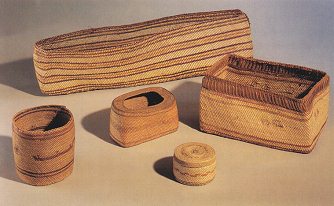
 Tins
and cans in wicker work of Nootka and Makah
primary nations (photo 3)
This wicker
work ware comes from North West coast of
Canada and is made in twining of cedar bast.
Fro the left to the right there are: basket
with ship and bird design (Nootka), little
basket with a margin (Makah), tin in wicker
work with tap (Nootka), rectangular basket
(Makah), and a long, narrow basket in the
background (Makah).
|
[Works in wicker work of
Hupa and Yurok primary nations of the western coast of
today's North California]
North California is the center of Overlay techniques with
ornaments. The thread for wicker work is covered with an
additional strap of colored material and is interlaced in
a way so the design is only visible on one side ("half
twist overlay") or on both sides ("full twist overlay").
Geometric designs on the kooking baskets and on the hats
of Hupa and Yurok primary nations are examples for the
first variation (photo 10). Spruce roots were used covered
with yellow "bear grass" or with black fern rods.
Wicker
work of Hupa and Pomo primary nations (today
California)
|
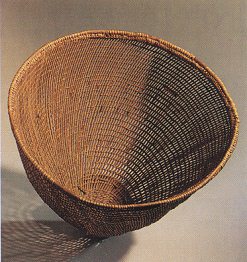
 Hamper
of Hupa primary nation (photo 5)
This wicker
basket is made in twining technique and was
taken by women with a strap on the forefront
taking good around, a kind of transport which
was widespread in the South West.
[and is widespread with South "American"
natives yet e.g. in Otavalo in Ecuador].
|
|
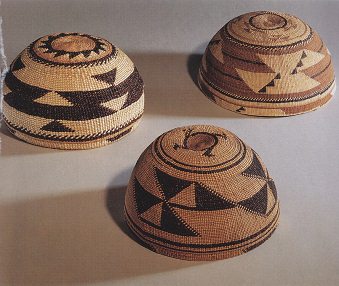
 Women
hats of Hupa primary nation (photo 10)
Such hats were
for women protecting their forehead so the
straps of the hampers taken to the forehead
were not damaging their skin. The hats are
made in twining and ornamented in "half twist
overlay" technique.
|
|
|
|
|
 |
 Jewelry basket
of Pomo primary nation (photo 8) Jewelry basket
of Pomo primary nation (photo 8)
In this little
basket there are feathers of read
headed woodpecker and of Californian
quail; the margin is ornamented with
little discs of seashells. This kind
of little jewelry baskets had a
symbolic meaning and were given to
girls, to brides and to other women
being in a transformation stadium in
their life.
|
|
[Works of wicker work of
Hopi primary nation in today's Arizona]
South West [of the North American continent] is the center
of all baskets worked in coiling technique. This is also
the region from where most of commercially produced wicker
works are coming from. Above all the flat bowls of Hopi
primary nation of the second Mesa (photo 11) are well
worked and are one of the best loved models until today
[1990s]. (Pueblo natives built their villages mainly in
caves by defense reasons, on three "Mesas" of Colorado
tableland, a sparse mountain range in table form in the
half desert of Northern Arizona). The thick beads of these
flat bowls consist in yucca fibers fixed with regular
stitches. The design mostly is coming out to the edge and
can be geometric or can be the illustration of natural
objects like clouds, feathers, birds, humans, kachinas
etc. Geometric designs are mostly spread over the whole
bowl. Naturalist designs normally consist in a symmetry,
and many times there is no balance between upper and lower
half. The designs are in yellow, red, blue and green. The
colors are from natural substances (p.28).
Wicker
work of Hopi primary nation (today in Arizona)
|
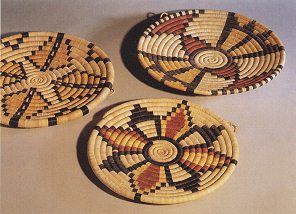
 Little
bowls in wicker work of Hopi primary nation in
coil-built technique (photo 11)
These three
flat bowls were made on the second Mesa in
coiling technique.
|
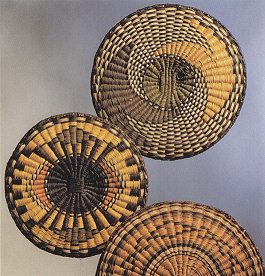
 Little
bowls of Hopi primary nation in wicker work,
back side (photo 2)
These three
flat bowls seen here on their back were
braided in wicker technique.
|
|
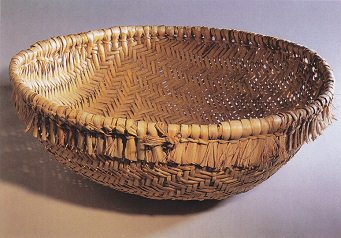
 Ring basket of Hopi
primary nation for corn washing (photo 9)
These round or oval ring
baskets were used already before the white
imperialist came. They were used for corn
washing and can be found today yet in the Hopi
villages. Today they often have colored
designs. The baskets are reinforced on the top
with a wooden ring and are made in a simple
wicker work technique of yucca fibers.
|
Bowls and flat basket plates of Hopi primary nation in
simple
wicker technique
have got a high quality and only come from villages from
the third Mesa. They consist of a hard framework
consisting of rod of "Wild Currant" - a kind of barberry -
and is braided by branches of "rabbit brush". These works
have got similar designed ornaments like the baskets on
coiling technique, but the colors are not to brilliant
(photo 6).
Wicker
work of other primary nations (today Arizona)
|
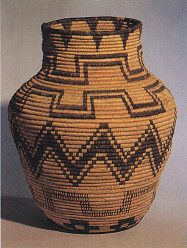
 Storage
basket in form of a jar of San Carlos Apache
primary nation (today Arizona) (photo 4)
Storage jar of
San Carlos Apaches, made in 1920 in coiling
technique.
|
|
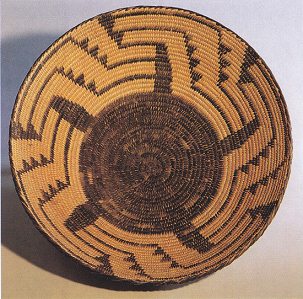
 Bowl
of Pima primary nation (today Arizona) (photo
7)
This basket
was made in around 1930 in coiling technique.
|
[Flat bowl baskets -
"wedding baskets" of Hopi and Navajo primary nations]
Flat bowls which are called wedding baskets are well known
with
Hopi
and
Navajo
primary nations. Hopi's wedding baskets can be worked in
wicker technique or in coiling technique and have got a
star's design. As a part of the wedding ceremony the bride
is taking corn meal into the house of the future groom -
with this wedding basket. For the groom this wedding
basket is a precondition for getting to the beyond after
his death. At Navajo primary nation groom and bride are
eating corn porridge together during the wedding ceremony
- from this wedding basket, and add to this they offer
this corn porridge also to their guests. In the past this
wedding basket was bewared until one of the partners died
and then was burnt. Today it is often given to another
bridal couple.
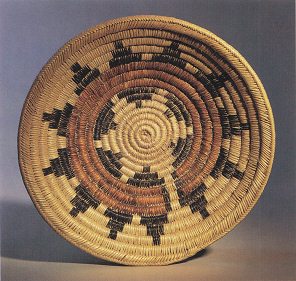
 Wedding
basket of Navajo primary nation (today above
all in Arizona and New Mexico) (photo 6)
Wedding
baskets with a star as design were very
distributed with Hopi and Navajo primary
nations. This basket was made in coiling
technique [?].
|
Making of wedding baskets of Navajo was ruled by hard
rules. The colored design has got a red core surrounded by
black jags, and in one place there is an outlet (photo 6).
By this "spiritual path" the spiritual forces are said
arriving and leaving. The design represents the mountains
and valleys of the world of the living and of the
netherworld, that means spiritual and material world. The
end of the coil can be found always at the level of
the "spiritual path", so this path will also be marked
when the basket is filled with corn porridge. Hopi and
Navajo are using these wedding baskets until today
[1990s]. But Navajo's wedding baskets are produced by
other groups - above all by Papago primary nation (p.29).






 Hat
for wale hunting of Nootka primary nation
(photo 1)
Hat
for wale hunting of Nootka primary nation
(photo 1)







